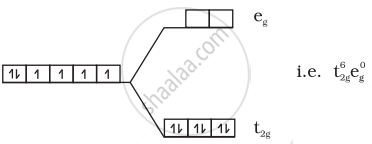Advertisements
Advertisements
प्रश्न
Using crystal field theory, draw energy level diagram, write electronic configuration of the central metal atom/ion and determine the magnetic moment value in the following:
\[\ce{[CoF6]^{3-}, [Co(H2O)6]^{2+}, [Co(Cn)6]^{3-}}\]
उत्तर
(1) \[\ce{[CoF6]^{3-}}\]:
\[\ce{Co^{3+} = 3d^6}\]
Number of unpaired electrons = 4
Magnetic moment = `sqrt(n(n + 2)) = sqrt(4(4 + 2))` = 4.9 BM
(ii) \[\ce{[Co(H2O)6]^{2+}}\]:

\[\ce{Co^{2+} = 3d^7}\]
Number of unpaired electrons = 3
Magnetic moment = `sqrt(3(3 + 2))` = 3.87 BM
(iii) \[\ce{[Co(CN)6]^{3-}}\]:

\[\ce{Co^{3+} = 3d^6}\]
No unpaired electrons so diamagnetic.
APPEARS IN
संबंधित प्रश्न
On the basis of crystal field theory, write the electronic configuration for d4 ion if ∆0 < P.
Complete and balance the following reactions:
(1) P4 + H2SO4 → ____ + _____ + _____ + _____
(2) Ag + HNO3(dilute) → _____ + ______ + _____ + _____
Why are low spin tetrahedral complexes not formed?
Arrange following complex ions in increasing order of crystal field splitting energy (∆O):
\[\ce{[Cr(Cl)6]^{3-}, [Cr(CN)6]^{3-}, [Cr(NH3)6]^{3+}}\].
\[\ce{CuSO4 . 5H2O}\] is blue in colour while \[\ce{CuSO4}\] is colourless. Why?
The CFSE for octahedral [CoCl6]−4 is 18,000 cm−1. What will be the CFSE for tetrahedral [CoCl3]−2?
The CFSE of [CoCl6]3– is 18000 cm–1 the CFSE for [CoCl4]– will be ______.
Using crystal field theory, write the electronic configuration of d5 ion, if Δ0 > P.
What is crystal field splitting energy?
On the basis of crystal field theory, write the electronic configuration for d4 with a strong field ligand for which Δ0 > P.
